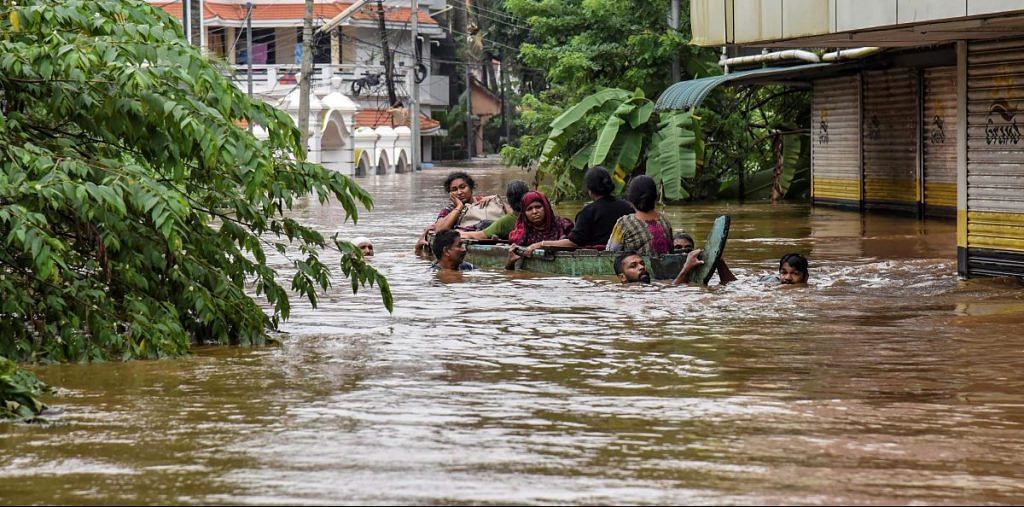There has been excessive rainfall in Kerala this year, but there are several more factors why it has become the state’s greatest disaster in almost a century.
Bengaluru: Over 300 people have lost their lives and over six lakh people have so far been confirmed displaced in the worst floods to hit Kerala in nearly a century. Chief minister Pinarayi Vijayan says according to initial estimates, two disastrous weeks of rain have caused a loss of upwards of Rs 20,000 crore.
Amid the frantic rescue and relief operations, there’s finally some good news – rainfall is predicted to abate over the next 24 to 48 hours, and water is expected to recede.
It is important to understand the science behind what went wrong, and how such disasters can be averted in future.
Also Read: Kerala floods: Some abnormal weather, but mostly a man-made calamity
Science of the monsoon
In scientific terms, the south-west monsoon over India is formed when hot, low pressure regions in central Asia and the Thar desert pull in humid winds from the high pressure Indian Ocean. As the winds hit the country, they provide over 80 per cent of India’s annual rainfall.
The monsoon originating from the Arabian Sea hits Kerala first, in June, reaching Delhi by the beginning of July. The Bay of Bengal winds start off at the Coromandel Coast, going upward to Odisha and then the Northeast.
Together, these moisture-laden winds drench the entire country in July-August, with more rain in the southern states than the north.
Since India is an agricultural nation, the south-west monsoon is often called the most productive rainy season on the planet.
Factors behind the calamity
There were several reasons that contributed to the flooding this year in Kerala.
First, rainfall this season has been abnormally high. According to the Indian Meteorological Department (IMD), a total of 2091.1mm rainfall has been registered this year, against the previous average of 1606.7mm – nearly 30 per cent more.
On 16 August, Kerala received nearly ten times the usual rainfall for this calendar day, making it the wettest day of the decade. Of all the 14 districts, Idukki received the most rainfall, followed by Ernakulam. Both districts, along with Palakkad and Malappuram, have been badly affected.
Second, in the 80 days of the monsoon season so far since 1 June, Kerala has seen rainfall on 67 days. Usually, the state sees a couple of days of rain interspersed with dry spells, but this time, torrential rain has bombarded the state almost continuously, not allowing time for the water to drain away.
Dam officials’ error
Third, dams require periodic, slow release of water throughout the season. Every dam has something called a ‘rule curve’, which specifies exactly how much water is to be released when the reservoir reaches certain levels.
Officials have admitted to ignoring this rule, a common practice to keep the dams full even after the monsoon stops. This year, state authorities were forced to open the dam gates after full capacity was reached, thus releasing excessively large quantities of water into a state that was already being bombarded with heavy rainfall.
Also Read: Who visited Kerala’s flood-hit first?’ BJP finds a way to score brownie points
The five radial floodgates of Asia’s largest arch dam, the Idukki Dam, were opened together for the first time in history. In fact, 35 out of 42 dams in the state were opened for the first time in history, that too during the monsoon season. Had 30 of the dams gradually released water when they were supposed to, a lot of the damage could have been contained, disaster response authorities have pointed out.
No NDRF battalion
Furthermore, the National Disaster Response Force (NDRF) mandates each state to have at least one battalion to kick into action during natural disasters. Kerala does not have any yet, despite the state being ranked seventh most prone to flooding.
The Centre has now dispatched 53 teams consisting of 45 personnel each. Nine columns and eight teams of the Army’s engineering task force, 22 Coast Guard teams, 24 Navy diving teams, as well as aircraft, helicopters, and boats are engaged in rescue in Kerala as of last week.
Several relief efforts and pleas for donations have sprung all over the country, a lot of them efficiently managed on social media and through mobile applications. To see how you can help, check our consolidated list of places to donate, request and offer aid, and volunteering.
Also Read: Devastating Kerala floods: National indifference or political partisanship?
